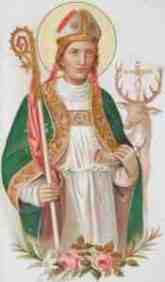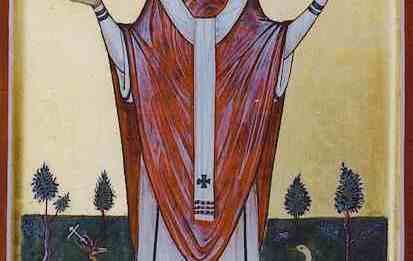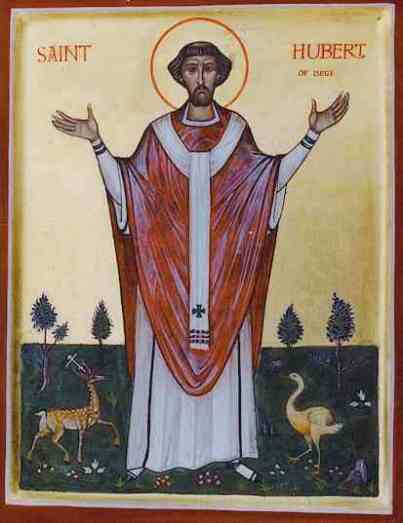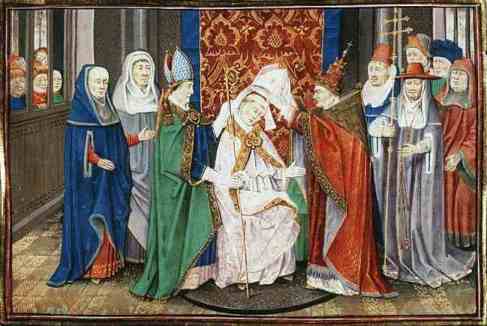
St. Hubert
Bishop of Maastricht, Netherlands, and disciple of St. Lambert. Hubert was a married courtier serving Pepin of Heristal, France. He reportedly had a vision of a crucifix between the horns of a stag while hunting. Widowed, he is believed to have entered Stavelot Monastery, Belgium, and was ordained by St. Lambert at Maastricht. He succeeded St. Lambert about 705 as bishop. Hubert erected a shrine for St. Lambert’s relics at Liege, France. He was noted for his miracles and for converting hundreds. Hubert died at Tervueren, near Brussels, Belgium, on May 30. He is a patron saint of hunters.
St. Hubertus or Hubert (c. 656–727 A.D.) was the first Bishop of Liège. He was a Christian saint who was the patron saint of hunters, mathematicians, opticians, and metalworkers. Known as the Apostle of the Ardennes, he was called upon to cure rabies until the early 20th century through the use of the traditional St Hubert’s Key.
Saint Hubertus was widely venerated during the Middle Ages. The iconography of his legend is entangled with the legend of Saint Eustace. The Bollandists published seven early lives of this popular saint (Acta Sanctorum, November, i., 759–930 A.D.); the first of these was the work of a contemporary. Unfortunately, it is very sparing of details.
He died 30 May 727 A.D. in Tervuren near Brussels, Belgium. His feast day is November 3.
Youth
Saint Hubertus was born (probably in Toulouse) about 656 A.D. He was the eldest son and the heir apparent of Boggis, the Duke of Aquitaine.
As a youth, Hubert was sent to the Neustrian court of Theuderic III at Paris, where his charm and agreeable address led to his investment with the dignity of “count of the palace”. Like many nobles of the time, Hubert was addicted to the chase. Meanwhile, the tyrannical conduct of Ebroin, mayor of the Neustrian palace, caused a general emigration of the nobles and others to the court of Austrasia at Metz. Hubert soon followed them and was warmly welcomed by Pippin of Heristal, mayor of the palace, who created him almost immediately grand-master of the household. About this time (682) Hubert married Floribanne, daughter of Dagobert, Count of Leuven, a great and suitable match. Their son Floribert would later become bishop of Liège, for bishoprics were all but accounted fiefs heritable in the great families of the Merovingian kingdoms..
Hubert’s withdrawal
His wife died giving birth to their son, and Hubert retreated from the court, withdrew into the forested Ardennes, and gave himself up entirely to hunting. But a great spiritual revolution was imminent. On Good Friday morning, when the faithful were crowding the churches, Hubert sallied forth to the chase. As he was pursuing a magnificent stag or hart, the animal turned and, as the pious legend narrates, he was astounded at perceiving a crucifix standing between its antlers, while he heard a voice saying: “Hubert, unless thou turnest to the Lord, and leadest an holy life, thou shalt quickly go down into hell”. Hubert dismounted, prostrated himself and said, “Lord, what wouldst Thou have me do?” He received the answer, “Go and seek Lambert, and he will instruct you.”
The story of the hart appears first in one of the later legendary hagiographies (Bibliotheca hagiographica latina, nos. 3994–4002) and has been appropriated from the legend of Saint Eustace or Placidus. It was first attributed to St. Hubert in the 15th century.
Hubert as a cleric and bishop
Be that as it may, Hubert set out immediately for Maastricht, for there Lambert was bishop. Saint Lambert received Hubert kindly, and became his spiritual director. Hubert now renounced all his very considerable honors, and gave up his birthright to the Aquitaine to his younger brother Odo, whom he made guardian of his infant son, Floribert. Having distributed all his personal wealth among the poor, he studied for the priesthood, was soon ordained, and shortly afterwards became one of St. Lambert’s chief associates in the administration of his diocese. By the advice of St. Lambert, Hubert made a pilgrimage to Rome in 708, but during his absence, Lambert was assassinated by the followers of Pippin. According to the hagiographies of Hubert, this act was simultaneously revealed to the pope in a vision, together with an injunction to appoint Hubert bishop of Maastricht.
He distributed his episcopal revenues among the poor, was diligent in fasting and prayer, and became famous for his eloquence in the pulpit. In 720, in obedience to a vision, Hubert translated St. Lambert’s remains from Maastricht to Liège with great pomp and ceremonial, several neighboring bishops assisting. A basilica for the relics was built upon the site of Lambert’s martyrdom, and was made a cathedral the following year, the see being removed from Maastricht to Liège, then only a small village. This laid the foundation of the future greatness of Liège, of which Saint Lambert is honored as patron, and Saint Hubert as founder and first bishop.
Hubert actively evangelised among the pagans in the extensive Ardennes forests and in Toxandria, a district stretching from near Tongeren to the confluence of the Waal and the Rhine.
Veneration
Saint Hubert was widely venerated in the Middle Ages and partly because of his noble birth several military orders were named after him: the Bavarian, the Bohemian and that of the Archbishop-Elector of Cologne. Saint Hubert of Liège is patron of archers; dogs; forest workers; hunting; huntsmen; Liege, Belgium; mathematicians; metal workers; Saint-Lamberge, Belgium; smelters; and trappers. Hubertus, along with Quirinus of Neuss, Cornelius and Anthony, was venerated as one of the Four Holy Marshals (‘Vier Marschälle Gottes) in the Rhineland. The St. Hubertus Orden (Order of Saint Hubert), a chivalric order, was founded in 1444 by Gerhard V of Jülich and Berg. In the Anglican Communion, at least two churches were dedicated to Saint Hubertus within the Church of England.



